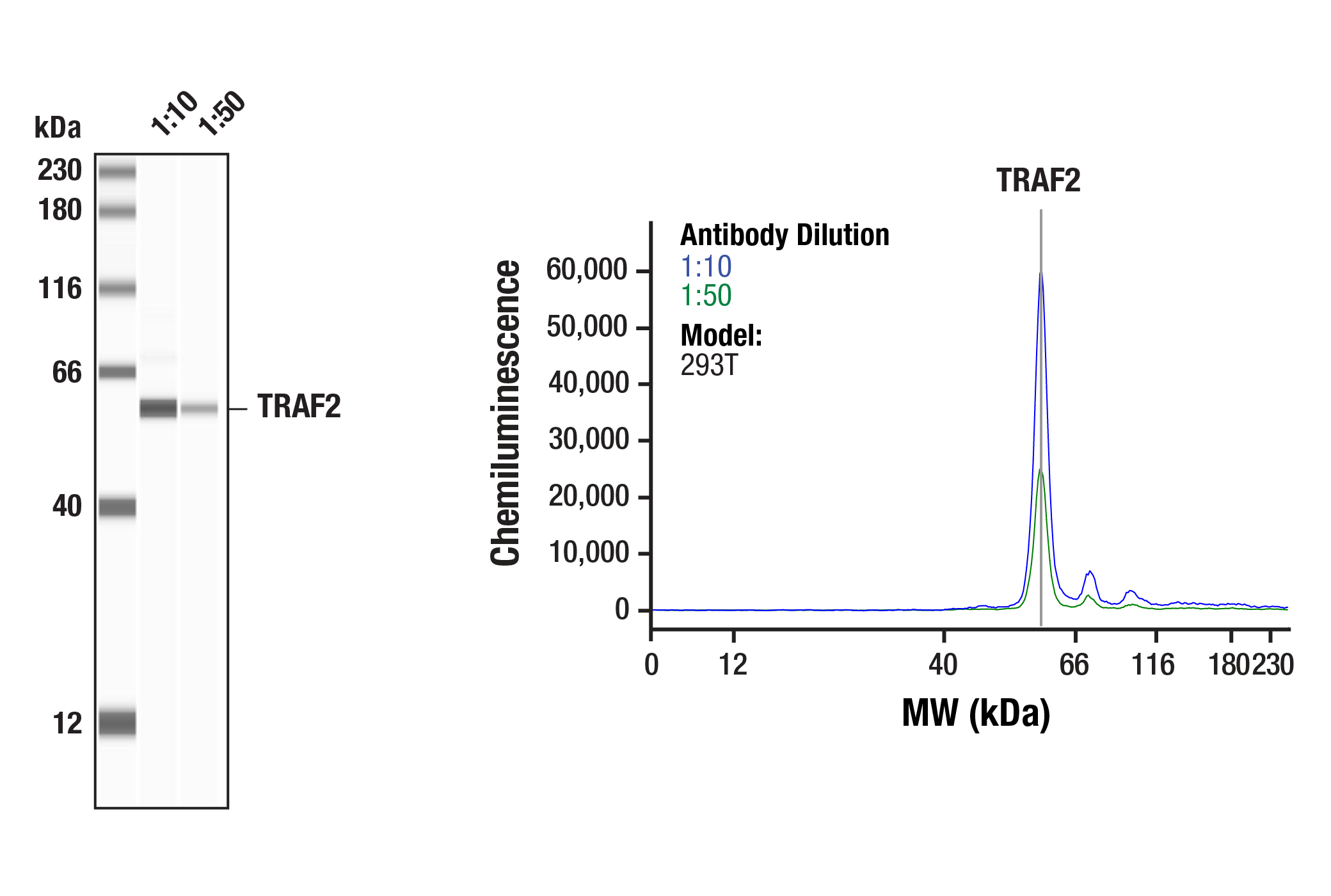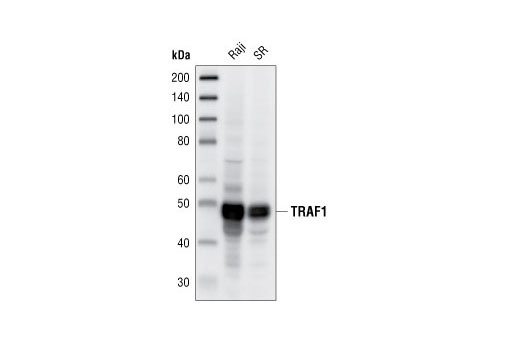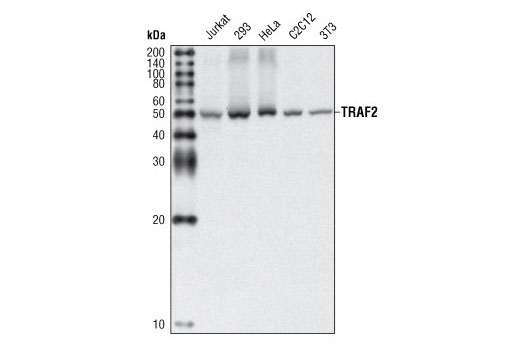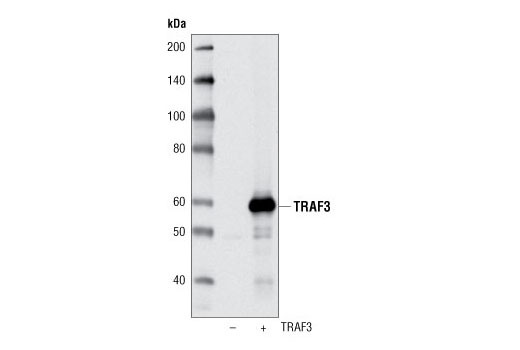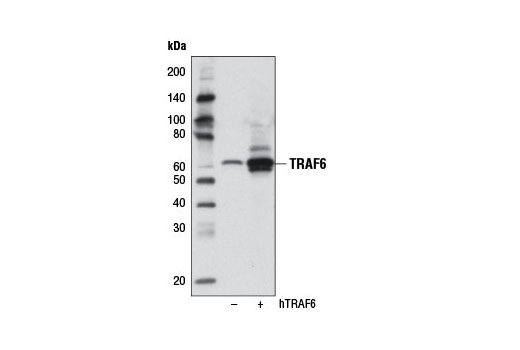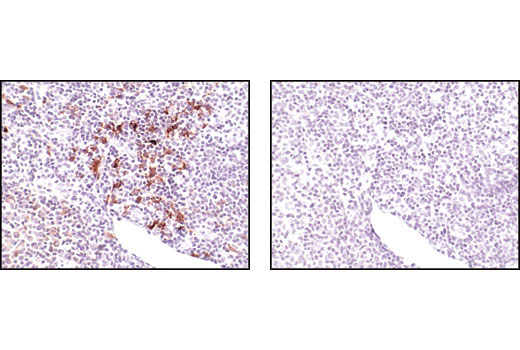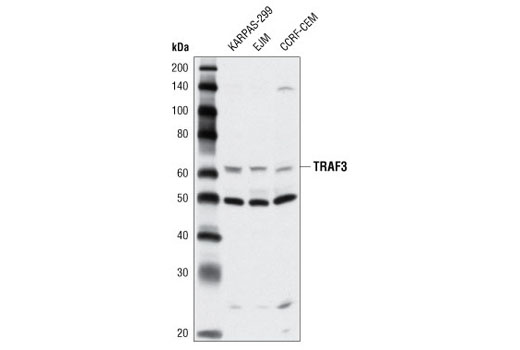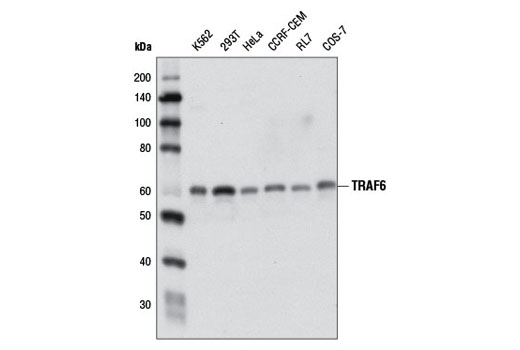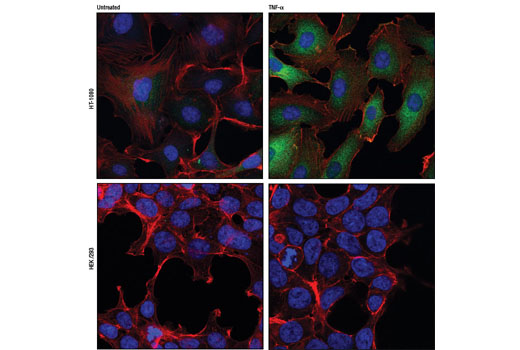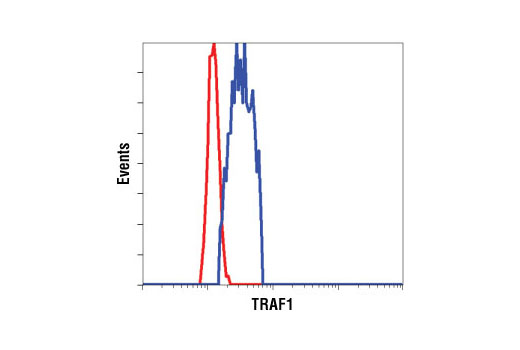| Product Includes | Product # | Quantity | Mol. Wt | Isotype/Source |
|---|---|---|---|---|
| TRAF1 (45D3) Rabbit mAb | 4715 | 20 µl | 50 kDa | Rabbit |
| TRAF2 (C192) Antibody | 4724 | 20 µl | 53 kDa | Rabbit |
| TRAF3 Antibody | 4729 | 20 µl | 62 kDa | Rabbit |
| TRAF6 (D21G3) Rabbit mAb | 8028 | 20 µl | 60 kDa | Rabbit IgG |
| Anti-rabbit IgG, HRP-linked Antibody | 7074 | 100 µl | Goat |
Please visit cellsignal.com for individual component applications, species cross-reactivity, dilutions, protocols, and additional product information.
Description
The TRAF Antibody Sampler Kit provides an economical means to evaluate endogenous levels of TRAF1, 2, 3, and 6. The kit contains enough primary and secondary antibodies to perform two western mini-blot experiments.
Storage
Background
TRAFs (TNF receptor-associated factors) are a family of multifunctional adaptor proteins that bind to surface receptors and recruit additional proteins to form multiprotein signaling complexes capable of promoting cellular responses (1-3). Members of the TRAF family share a common carboxy-terminal "TRAF domain", which mediates interactions with associated proteins; many also contain amino-terminal Zinc/RING finger motifs. The first TRAFs identified, TRAF1 and TRAF2, were found by virtue of their interactions with the cytoplasmic domain of TNF-receptor 2 (TNFRII) (4). The six known TRAFs (TRAF1-6) act as adaptor proteins for a wide range of cell surface receptors and participate in the regulation of cell survival, proliferation, differentiation, and stress responses.
While TRAF2 was originally described through its interaction with TNFRII, it has since been shown to interact with other surface receptors including CD27, CD30, CD40, 4-1BB, Ox40, HVEM/ATAR, and LMP-1 (1-3). TRAF2 also associates with a large number of intracellular proteins, including TRADD, FADD, I-TRAF/TANK, TRIP, A20, c-IAP1 and 2, Casper, RIP, and NIK, which help to regulate cell survival. Dominant negative and knockout studies have shown that TRAF2 plays an important role in TNF-mediated activation of NF-κB and the MAPK/JNK kinase pathway (5-7).
TRAF6 plays a critical role in innate and adaptive immunity, bone metabolism, and development of certain tissues including the nervous system (8). TRAF6 deficiency results in osteopetrosis and defective IL-1, CD40, and LPS signaling (9) as well as defects in neuronal development (10). Unlike other TRAF family members that mediate signaling through TNF, TRAF6 has unique binding activities (11) that result in signaling responses from the interleukin-1 receptor (IL-1R) (12), toll-like receptor (13,14), CD (15), RANK (16,17), and p75 neurotrophin receptor (18). TRAF6 associates directly with CD40 and RANK, and indirectly with IL-1R/TLR through IRAK (13). This leads to activation of NF-κB and MAP kinase signaling pathways through downstream association with the TAB/TAK-1 complex (19). TRAF6 also activates Src family nonreceptor tyrosine kinases leading to Akt activation (20).
- Arch, R.H. et al. (1998) Genes Dev 12, 2821-30.
- Chung, J.Y. et al. (2002) J Cell Sci 115, 679-88.
- Bradley, J.R. and Pober, J.S. (2001) Oncogene 20, 6482-91.
- Rothe, M. et al. (1994) Cell 78, 681-92.
- Yeh, W.C. et al. (1997) Immunity 7, 715-25.
- Reinhard, C. et al. (1997) EMBO J 16, 1080-92.
- Rothe, M. et al. (1995) Science 269, 1424-7.
- Wu, H. and Arron, J.R. (2003) Bioessays 25, 1096-105.
- Lomaga, M.A. et al. (1999) Genes Dev 13, 1015-24.
- Lomaga, M.A. et al. (2000) J Neurosci 20, 7384-93.
- Ye, H. et al. (2002) Nature 418, 443-7.
- Cao, Z. et al. (1996) Nature 383, 443-6.
- Muzio, M. et al. (1997) Science 278, 1612-5.
- Medzhitov, R. et al. (1998) Mol Cell 2, 253-8.
- Ishida, T. et al. (1996) J Biol Chem 271, 28745-8.
- Darnay, B.G. et al. (1998) J Biol Chem 273, 20551-5.
- Wong, B.R. et al. (1998) J Biol Chem 273, 28355-9.
- Khursigara, G. et al. (1999) J Biol Chem 274, 2597-600.
- Ninomiya-Tsuji, J. et al. (1999) Nature 398, 252-6.
- Wong, B.R. et al. (1999) Mol Cell 4, 1041-9.
Background References
Trademarks and Patents
限制使用
除非 CST 的合法授书代表以书面形式书行明确同意,否书以下条款适用于 CST、其关书方或分书商提供的书品。 任何书充本条款或与本条款不同的客书条款和条件,除非书 CST 的合法授书代表以书面形式书独接受, 否书均被拒书,并且无效。
专品专有“专供研究使用”的专专或专似的专专声明, 且未专得美国食品和专品管理局或其他外国或国内专管机专专专任何用途的批准、准专或专可。客专不得将任何专品用于任何专断或治专目的, 或以任何不符合专专声明的方式使用专品。CST 专售或专可的专品提供专作专最专用专的客专,且专用于研专用途。将专品用于专断、专防或治专目的, 或专专售(专独或作专专成)或其他商专目的而专专专品,均需要 CST 的专独专可。客专:(a) 不得专独或与其他材料专合向任何第三方出售、专可、 出借、捐专或以其他方式专专或提供任何专品,或使用专品制造任何商专专品,(b) 不得复制、修改、逆向工程、反专专、 反专专专品或以其他方式专专专专专品的基专专专或技专,或使用专品开专任何与 CST 的专品或服专专争的专品或服专, (c) 不得更改或专除专品上的任何商专、商品名称、徽专、专利或版专声明或专专,(d) 只能根据 CST 的专品专售条款和任何适用文档使用专品, (e) 专遵守客专与专品一起使用的任何第三方专品或服专的任何专可、服专条款或专似专专
